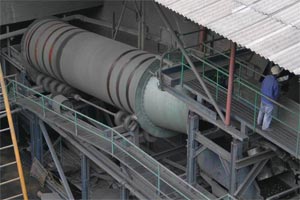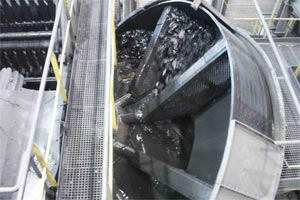Coal washing plant

Coal Washing machine reduces the ash content of coal by over 50%, resulting in less waste. About 25% of the sulfur content is reduced, lowering the amount of sulfur dioxide emissions released upon combustion.
Coal washing plant also improves the heating value of coal, known as the thermal efficiency, which reduces carbon dioxide emissions as well.
Flow chart for coal washing
Coal beneficiation largely depends on gravity difference of coal and ash particle.
Coal Washing - There are two coal cleaning processes that predominate in the industry: dense medium (DM) separation and JIG washing. JIG washing, which is a water-based process that relies on the pulsation of water through the particle bed to stratify particles of different density, is widely perceived as a simpler, lower-cost option than DM separation.
Coal is first ground into smaller pieces so that it can be more easily processed. The pulverized coal is then washed in water or in fluids with densities that cause the coal to float so that unwanted impurities can sink to the bottom.
Coal washing machine
Coal washing is accomplished by one of two major processes, by density separation or by froth flotation.
Machine used in density separation
 A number of coal washing machine and systems have been developed for extracting the various components of coal once they have been separated with a water or heavy medium treatment.
A number of coal washing machine and systems have been developed for extracting the various components of coal once they have been separated with a water or heavy medium treatment.
One of the oldest of these devices is the jig. In a jig, the column of water is maintained in a constant up-and-down movement by means of a flow of air. Clean coal particles are carried to the top of the jig by this motion, while heavier refuse particles sink to the bottom.
CycloneAnother method of extraction, the cyclone, consists of a tank in which the working fluid (water or a heavy medium) is kept in a constant circular motion. The tank is constructed so that lighter clean coal particles are thrown out of one side, while heavier refuse particles are ejected through the bottom.
Shaking tablesShaking tables are another extraction method. As the table shakes back and forth, particles are separated by size, producing clean coal at one end and waste products at the other.
cylindrical separatorsIn cylindrical separators, a coal mixture is fed into a spinning column of air that throws the heavier waste particles outward. They coat the inner wall of the cylinder and fall to the bottom, where they are drawn off. The clean coal particles remain in the center of the air column and are drawn off at the top of the cylinder.
There are two classes of dense medium separators, the bath- or vessel-type separator for coarse coal in the range 75 mm- 12 mm and the cyclone-type separator cleaning coal in the range 5 mm - 0.5 mm.
Machine used in flatation process
Froth flotation processes depend on the production of tiny air bubbles to which coal particles adhere. The amount of absorption onto a bubble depends not only on a particle's density, but also on certain surface characteristics. Separation of clean coal from waste materials can be achieved in froth flotation by varying factors, such as pH of the solution, time of treatment, particle size and shape, rate of aeration, solution density, and bubble size.
SBM is a famous coal washing machine manufacturer in China, and offer coal crusher, grinding, mill, screen, washing machine like jigger, Shaking tables, cylindrical separators, spiral classifier, flotation unit for coal washing plant in India, Russia, Canada, Vietnam, Indonesia, Australia China, USA, Germany, South Africa, Poland, Zimbabwe, Columbia, Pakistan, Philippines.
Coal Processing
- » Stone Crushing Plant
- » Sand Making Plant
- » Coal Crushing Plant
- » Concrete Production Line
- » Cement Plant
- » Ore Processing
- » Construction Waste Recycling
- » Gold Mining Equipment
- » Aggregate Crushing Plant
- » Ballast Crushing & Screening Plant
- » Stone Grinding
- » Mining equipment
- » Stone quarry plant
- - Tel:0086-21-58386189
- - Fax:0086-21-58383058
- - Email:

